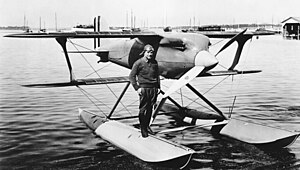Curtiss R3C
| Curtiss R3C | |
|---|---|
 |
|
| Curtiss R3C-2 | |
| Role | Racing aircraft |
| Manufacturer | Curtiss Aeroplane and Motor Company |
| First flight | 18 September 1925 |
| Introduction | 1925 |
| Primary users | US Navy US Army |
| Number built | 3 |
| Developed from | Curtiss R2C |
The Curtiss R3C was an American racing aircraft built in landplane and floatplane form. It was a single-seat biplane built by the Curtiss Aeroplane and Motor Company.
The R3C-1 was the landplane version and Cyrus Bettis won the Pulitzer Trophy Race in one on 12 October 1925 with a speed of 248.9 mph (406.5 km/h).
The R3C-2 was a twin float seaplane built for the Schneider Trophy race. In 1925, it took place at Chesapeake Bay in Baltimore, Maryland. With 232.57 mph (374.274 km/h), pilot Jimmy Doolittle won the trophy with a Curtiss R3C-2. The other two R3C-2s, piloted by George Cuddihy and Ralph Oftsie, did not reach the finish line. The next day, with the same plane on a straight course, Doolittle reached 245.7 mph (395.4 km/h), a new world record. For the next Schneider Trophy, which took place on 13 November 1926, the R3C-2's engine was further improved, and pilot Christian Franck Schilt won second place with 231.364 mph (372.34 km/h).
The R3C-2 that Jimmy Doolitle piloted to victory in the 1925 Schneider Trophy race is preserved at the National Air and Space Museum's Steven F. Udvar-Hazy Centre, at Washington Dulles Airport, Virginia. It still wears its '3' 1925 racing number.
Data from Curtiss Aircraft 1907–1947
General characteristics
Performance
...
Wikipedia
